 As fans of kung fu cinema, we can certainly never be accused of having it easy when it comes to the movies we love. Deleted scenes that may or may not exist, alternate endings that are considered lost, and copious amounts of additional footage known to be destroyed are just some of the lamentable realities the genre comes with.
As fans of kung fu cinema, we can certainly never be accused of having it easy when it comes to the movies we love. Deleted scenes that may or may not exist, alternate endings that are considered lost, and copious amounts of additional footage known to be destroyed are just some of the lamentable realities the genre comes with.
However at least with the scenarios described above, we can say they apply to movies that saw the light of day in some form of another. For this feature, we’ll be looking at 25 martial arts movies that remain incomplete. Ranging from Bruceploitation mysteries, through to proposed sequels to Van Damme classics, the series of unfortunate events that lead to a production grinding to a halt usually boil down to a handful of factors, but the variety of movies impacted is considerably broader.
As usual, we applied some simple criteria. Firstly, the movie in question needs to have not been completed. So for example, Charlie Nguyen’s Chinatown from 2013, doesn’t count. Sure it got banned by the Vietnamese government, so the original cut seems increasingly unlikely of surfacing anywhere, however it was completed. Likewise for Bruce Lee’s Game of Death, no doubt Robert Clouse’s version is about as far away from Lee’s original vision as one can get, however, it was technically completed. Secondly, for those movies that never even had a chance to start filming, it needs to be a title which was at least officially announced. This one is mainly so the list doesn’t become dedicated to the 100 titles Donnie Yen’s name has been attached to in the last decade, of which about 5% actually got made.
So, without further ado, listed by year the production was announced, starting from most recent, check out the list below –
Kickboxer: City of Blood (2014) – There was a time when it looked like we’d be getting 2 new Kickboxer movies, but eventually only one emerged in the form of Kickboxer: Vengeance. The other, titled City of Blood, was due to star Sasha Mitchell reprising his role as David Sloan, and would reunite him with Kickboxer 2 and 4 director Albert Pyun. Originally planned to be a webseries, it was eventually announced that it would be a feature length movie, and would have Sloan fighting Al-Qaeda terrorists in Somalia (!?)
As pre-production progressed it was revealed that both Dennis Chan and Michel Qissi (Tong Po!) would be returning from the original series, and Hammer Girl herself, Julie Estelle (The Raid 2), was on-board as a secret agent. Unfortunately in mid-2015, Pyun announced that the production was on hold due to his ongoing battle with multiple sclerosis, which he was diagnosed with in 2012, and it seems to have disappeared from the radar since then.
Garuda 7 (2014) – When is a movie not a movie? Well, apparently when it’s only a trailer, but one created with the intent of making audiences believe it was a full feature.
Billed as an Indonesian Expendables, and starring such talents from yesteryear as Willy Dozan (aka Billy Chong), John Ladalski, and Barry Prima, it was eventually revealed that the production crew only had enough funding to film a trailer, so that’s what they did.
Ladalski was in the producer’s chair and also set to choreograph the action, however in 2015 he confirmed in an interview that they were still looking for an investor. Sadly in July 2016 he passed away, and with his passing so also disappeared any chance of Garuda 7 ever being completed.
A Man will Rise (2013) – A 1950’s set Thai western that was due to be Tony Jaa’s first foray into the action comedy genre, A Man will Rise got plenty of attention thanks to Jaa approaching Dolph Lundgren to co-star as a villainous cowboy hitman. Lundgren agreed, on the basis that Jaa also co-star in one of his American movies, which became Skin Trade.
Filming had started, a press conference was held, and publicity shots were released featuring Jaa and Lundgren in costume, along with fellow co-stars Conan Stevens and David Ismalone. Unfortunately, Jaa’s long gestating feud with Sahamongkol Film came to a head during production, which resulted in whatever was filmed being shelved. With Sahamongkol maintaining ownership of the footage, and Jaa walking away from them, it’s unlikely that we’ll ever see A Man will Rise in any form.
Donnie Yen’s Super Hero Films production company: The Master and Dragon City (2013) – A failed business venture by Donnie Yen and Media Asia, initially announced at 2013’s Hong Kong Filmmart, by 2015 Super Hero Films had closed shop with nothing to show. Things weren’t always that way though, with Yen kicking off his new venture in style by announcing a pair of movies to be made under the banner.
The first was The Master, the tale of a HK immigrant who becomes a target for revenge after opening a kung fu school in 1970s America, and had Soi Cheang in the director’s chair. The second was Dragon City, to be helmed by Derek Kwok, which would focus on a group of gangsters operating in the infamous Kowloon Walled City in 1970s Hong Kong. Both projects would star Yen.
While Dragon City died a quiet death, The Master found itself inadvertently at the centre of an epic scam based out of Indonesia in 2016. A woman calling herself Li Duan Zhao had started contacting up and coming makeup artists in Europe, from an @huxia e-mail address, with job offers to work on the ‘upcoming Donnie Yen production, The Master’. Huxia is a state-owned distributor in China, so many believed the e-mail to be the real deal, including when they were told to buy their own ticket to Jakarta, and pay $1200 to the driver that would pick them up from the airport as a standard ‘ground tax’.
Despite The Master having been dead for a long time at this point, the fact that it still had an IMDB page gave the scammers the leverage they needed, and were able to convince a surprising amount of unsuspecting victims to travel to Indonesia and part with their cash.
Thai Double Bill: Chocolate 2 and Formless (2011) – Tom Yum Goong 2 took over 3 years to eventually reach screens since it began development in 2010, surely some kind of record for a martial arts movie. Its constant hold-ups, due to the decision to film in 3D, Jija Yanin becoming pregnant mid-production, and late in the game cast additions like RZA, didn’t just damage the production’s own integrity, but resulted in 2 other planned titles being completely derailed.
The first was a sequel to Yanin’s 2008 breakout Chocolate, which (like the original and Tom Yum Goong 2) was to be helmed by Prachya Pinkaew. However after becoming a mother Yanin seemed happy to stick with supporting roles, her co-star status that was planned for Tom Yum Goong 2 being reduced to a supporting role, and the talk of Chocolate 2 soon disappeared altogether.
The other production was set to be a collaboration between Tom Yum Goong 2 heavy Marrese Crump, and Thai action legend Panna Rittikrai, titled Formless. Crump became a protégé of Rittikrai much like Jaa and Yanin, and Formless was set to be his Ong Bak. A rain soaked action concept video did the rounds in 2012, however with Crump tied down to Tom Yum Goong 2, production kept on getting pushed further and further out. Sadly with Rittikrai’s death in 2014, Formless was never meant to be. Crump last appeared in the 2016 Bollywood movie Sultan, which also featured Marko Zaror.
Snowblade (2011) – Intended to be a Hong Kong infused remake of Lady Snowblood, what was to be the directorial debut of Bey Logan shut down production less than a year in, after a major financer backed out.
In 2017, the original lead actress Sable Yu came forward to accuse Logan of sexual harassment on the set of Snowblade, alleging that he exposed himself in front of her, and insisting on her performing various scenes nude (Logan defended this point in a later statement, stating that these scenes were always in the script).
What’s more disturbing is that Logan went on to audition various other aspiring actresses in the subsequent years for the lead role, despite having no funding, seemingly with the main motivation of having a legitimate reason to ask them to get naked in front of him.
Scott Adkins Double Bill: Blood Hostage (2010) and Rage of the Tiger (2011) – Back in 2010, hot on the heels of working with director Isaac Florentine on Ninja and Undisputed III: Redemption, it looked like the pair were set to collaborate again on Blood Hostage. Casting Adkins as a former operative who travels from Israel to Lebanon to rescue his ex-wife’s new husband (I guess he didn’t get closure), the hype for this one heavily leaned on the fact it would feature the Israeli martial art Krav Maga. However the fact that it was also an Israeli co-production could be what resulted in it never getting past the initial stages, with the brewing political tension likely not making it the most attractive location to film. While Blood Hostage wasn’t mean to be, both Adkins and Florentine would reunite in 2013 for the sequel Ninja: Shadow of a Tear.
The following year in 2011, it was announced that the highly regarded action cinematographer, Ross Clarkson, would be making his directorial debut with Rage of the Tiger, which was set to shoot in Thailand and star Adkins in the lead. Clarkson was the man behind the lens for the Florentine directed Undisputed sequels and Ninja (he’d also work on the sequel Shadow of a Tear), so the pairing seemed like a perfect fit. Clarkson described the production as coming “With the fights of Bloodsport and the heart of Rocky”, and it would feature Adkins as a father forced into the world of illegal street fighting, to protect his family from a blood thirsty Triad leader. However in 2015 Clarkson was still seeking an executive producer to secure funding, and while on the Rage of the Tiger front everything has gone quiet, he will make his directorial debut in 2018 with the thriller Captured, which stars the Kickboxer reboots Sara Malakul Lane.
Mark Dacascos Double Bill: Song of the Knife and Man of Action (2010) – Fans of Mark Dacascos have spent over 20 years hoping he’d make another movie on the same level as 1997’s Drive, and in 2010 it looked like their hopes may be realized. Dacascos revealed that he was reuniting with Drive director Steve Wang, and Alpha Stunts founder Koichi Sakamoto, for a 3D martial arts movie titled Man of Action. The prospect of such a reunion almost seemed too good to be true, and apparently it was, as the project was unfortunately unable to get off the ground.
In the same year it looked like another Dacascos starring production, Song of the Knife, made more substantial progress, in which he was cast as a lonely assassin with a terminal illness, who has to rescue a cab driver that he’s fallen in love with (!?) after she’s kidnapped. Set to heavily feature Silat (no doubt thanks to 2009’s Merantau) and Kali, a promo reel was released and filming had started in February 2010, however (this will be a recurring theme) the financer pulled out not long after, grinding the production to a halt. When I interviewed Dacascos’ close friend Sonny Sison in July 2017, he’d hinted at the possibility of bringing the project back to the table as something which could be shot in the Philippines, but it’s safe to say that for now, Song of the Knife remains silent.
Defender 3D (2009) – After getting the attention of kung fu cinema enthusiasts with 2006’s Kiltro, Chilean martial artist Marko Zaror really made his mark a year later with Mirageman. A lo-fi tale of a guy who decides to become a superhero vigilante, for a while it looked like it was going to be the first Chilean fight flick to receive a Hollywood remake, when in 2009 it was announced that Defender 3D would be an English language vehicle for Zaror. Not only that, but it would be filmed in 3D.
However after months of silence, it was revealed that due to funding issues, the project was never able to get further than pre-production. While Defender 3D wasn’t meant to be, Zaror did get to star in an episode of the Marvel series The Defenders in 2017, and also scored roles in the Robert Rodriguez flicks Machete Kills and Alita: Battle Angel.
Hands of the Dragon (2008) – Back in 2008 kung fu fans had already been clamouring for martial artist Philip Ng to land a read role, after supporting turns in the likes of Dragon Squad and Invisible Target, and it seemed that Hands of the Dragon was going to be it. The story centred around a HK cop that’s left for dead, only to return with a new identity and hunt those down that tried to kill him.
Shooting had actually begun in India, and there was even a promotional clip released (which has long since been removed from YouTube), however not long into production a major financer pulled out, leaving the project high and dry. Ng would have to wait another 6 years to land a lead role, which came in the form of Once Upon a Time in Shanghai, and more recently played Bruce Lee in 2016’s Birth of the Dragon. Not a bad comeback all things considered.
Beat Down Boogie (2008) – After making his first feature length production with Contour in 2006, a couple of years later Eric Jacobus teamed up with filmmaker Micah Moore to make a sequel titled Beat Down Boogie, which would see him return as dodgy San Francisco tour guide Law. Billed as a “hip-hop chase and fight caper”, despite a mouth wateringly good all-action 3-minute preview, sadly the full movie never came to fruition. Jacobus and Moore would eventually work together on Dogs of Chinatown, with Jacobus himself going on to direct and star in another full length feature with 2012’s Death Grip.
As for Beat Down Boogie, Moore started his own production outfit under the banner, which came to an end during a bitter falling out between partners in 2017. While it almost seems criminal for the footage that was shot to never be used, unfortunately it looks like Beat Down Boogie is a tragic case of what could have been.
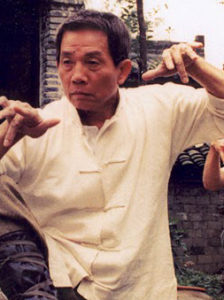
Lau Kar-Leung
Heroes of Shaolin (2006) – After a long absence from the screen, the legendary Lau Kar-Leung re-appeared in the mid-2000’s, choreographing and featuring in both Drunken Monkey (which he also directed) in 2003, and Seven Swords in 2005.
In 2006, at the age of 69, he announced he was preparing to make “the best martial arts movie ever made”, titled Heroes of Shaolin. Filming was due to take place in Mainland China, and Kar-Leung had already secured the services of his long-time friends Gordon Liu (who would play Pai Mei), Hsiao Hou, and Johnny Wang Lung-Wei.
Heroes of Shaolin was, strangely, being produced out of New York by a production outfit called Burning Shaolin Production, run by partners Michael Parrella and Damien Caldwell. When the pair ran out of money, it effectively derailed any chance of Heroes of Shaolin being made. With Lau Kar-Leung’s passing in 2013, sadly the best martial arts movie ever made can now never be.
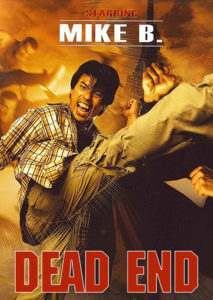
“Dead End” Fan Poster
Dead End (2006) – Initially planned to be a launching vehicle for Thai stuntman Mike B, Dead End was intended to bring a new action star to the fore, much like Ong Bak did for Tony Jaa. However shortly after shooting started the production ran into financial troubles, and filming stalled.
In the spirit of the Asso-Asia productions of old, the shot footage was eventually picked up and re-used for another Mike B starring vehicle, which became the 2009 released The Sanctuary. While reported cast members of Dead End, such as Korean actress Na Hyun-hee, were nowhere to be found in the new incarnation, The Sanctuary did bring onboard Romeo Must Die bad guy Russel Wong for some international flavour.
Despite Dead End being somewhat salvaged, neither The Sanctuary nor Brave, another Mike B vehicle, succeeded in creating a new action star, and he’s since faded into obscurity.
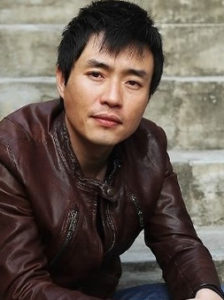
Ryoo Seung-wan
Yacha (2006) – After the success of City of Violence, director Ryoo Seung-wan planned another collaboration with Korea’s action director extraordinaire Jung Doo-hong and the Seoul Action School, which would take the form of an epic period battle flick against zombies. The timing would have been perfect, set for release in 2008, the same year that Red Cliff would kick off a trend of battlefield period pieces.
Yacha promised plentiful undead action, and would see Seung-wan directing a story that wasn’t his own for the first time, but with an estimated budget of US$10 million, securing the finances proved to be a tricker task. In 2010 he was still actively searching for an investor, but ultimately he’d still get a movie onscreen in 2008, with his homage to Korean action movies of old Dachimawa Lee.
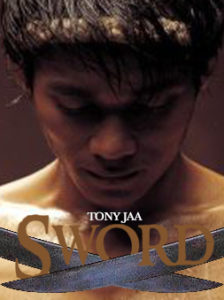
“Sword” Fan Poster
Sword (2005) – Back when it seemed like Tony Jaa could do no wrong, it was announced that following successful collaborations with director Prachya Pinkaew on Ong Bak and Tom Yum Goong, the pair would be reuniting for a third time on the period piece Sword. Much like Ong Bak focused on Muay Thai, and Tom Yum Goong on Muay Boran, so Sword was set to showcase the style of Dab Thai, a form of double-handed sword fighting.
While the promotional material at the 2005 Cannes Film Festival promised a swordplay saga the likes of which had never been seen before (Dab Thai is unique from other Asian sword techniques in that it integrates attacks using fists, feet, and knees), Jaa fell out with Pinkaew, and so began his well-covered dispute with Sahamongkol Film. While Sword never did get off the ground, Jaa did maintain the planned period setting for what would become his own directorial debut, with 2008’s Ong Bak 2.
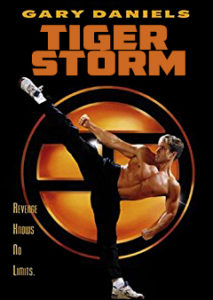
“Tiger Storm” Fan Poster
Tiger Storm (1996) – Gary Daniels was a busy man in the mid-90’s, and after working in Hong Kong with Jackie Chan on 1993’s City Hunter, a couple of years later he found himself back on the former British colony to film the action flick Tiger Storm. Filming had started, and even featured the debut of Charlene Houghton, legendary gweilo Mark Houghton’s daughter, playing the daughter of Daniels’ character. However the production soon ran into financial troubles, which halted filming.
Thankfully Keystone Pictures came in and purchased the footage with the intention of finishing the movie, however after reviewing what was filmed, they decided to scrap it and start over. With Daniels already on-board, the decision was made to re-locate proceedings Stateside (actually Canada), and re-name it The White Tiger (which ironically, is Mark Houghton’s nickname), that pitted him against Cary-Hiroyuki Tagawa.
Winners and Sinners 2 (1984) – Sammo Hung’s 1983 comedy Winners and Sinners became the prototype for what would become the hugely popular My Lucky Stars series, which often featured Jackie Chan and Yuen Biao in extended cameos or supporting roles. A promotional poster from the Golden Harvest archives revealed that a direct sequel to Winners and Sinners had started shooting, complete with stills from the footage already filmed with Sammo, Sibelle Hu, and the crew.
While it’s difficult to ascertain exactly what happened with the sequel, when Mike Leeder showed Richard Ng the images in 2015, Ng believed that they were from the 1985 released Twinkle Twinkle Lucky Stars. This would suggest that, while we may never know exactly how much was filmed with the intention of it being Winners and Sinners 2, at some point the project eventually morphed into Twinkle Twinkle Lucky Stars.
Hwang Jang Lee Directed Shaw Brothers Movie (1983) – After starring in several independent kung fu flicks and local Korean productions, in 1982 Hwang Jang Lee signed a contract with the already dwindling Shaw Brothers studio, and featured in The Kid from Kwangtung and Ghosts Galore. What’s less well known is that he was also contracted to direct a movie, and that filming had even started, with a cast featuring himself, Philip Kwok, and Wong Yue.
However the production didn’t go smoothly, with Hwang recalling in a 2014 interview that Wong Yue “didn’t focus on making the film, he was out of control. He did whatever he wanted. I was upset and so I wanted to change the actor, but they didn’t let me. And so I didn’t want to carry on and cancelled the project…” This led to a massive argument with Mona Fong, one which led to him breaching his contract and head back to Korea. He eventually returned to Hong Kong in 1985 to feature in Where’s Officer Tuba?

“Mark of the Eagle” Magazine Article (Source)
Mark of the Eagle (1980) – After Ti Lung and Alexander Fu Sheng had success together working on productions such as Sun Chung’s The Avenging Eagle and The Deadly Breaking Sword, director Chor Yuen decided to pair them up for 1980’s Mark of the Eagle. Disaster struck though when Fu Sheng broke his right leg, after a harness holding him in the air broke during the shooting of Heroes Shed No Tears, which was in production at the same time. The injury put the star out of work for the best part of 6 months, and stalled production on Mark of the Eagle.
However based on the available stills and plot description, it seems clear that the Shaw Brothers studio decided to push ahead, and Mark of the Eagle appears to have ultimately morphed into the Ti Lung starring vehicle The Convict Killer. In all likelihood, the role that Lau Wing plays was probably the one that Fu Sheng had started filming.
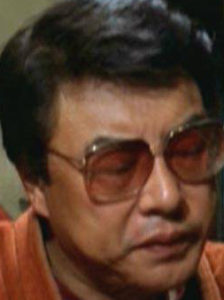
Li Han-Hsiang
Gambling for Heads (1976) – Not to be confused with the 1975 movie Gambling for Head, this particular title was a Shaw Brothers production, with a plot focusing on Chinese drug dealers operating out of Amsterdam. Popular SB sleaze director Li Han-Hsiang was at the helm, and had been filming locations in the UK before travelling to Amsterdam, which was where things went awry. Li was approached in his hotel room by a group of local Chinese residents, led by a man known only as Lee, who had a reputation as one of Amsterdam’s Chinese Godfathers. Lee believed the movie was about him, and proceeded to pull a gun on Li, demanding HK$200,000 if they wished to continue filming.
In typical Chinese style, Li actually bargained the gangster down to half price, however when he contacted Run Run Shaw to let him know of the situation, the SB boss requested he and his crew return to Hong Kong for their own safety, and the production was cancelled.
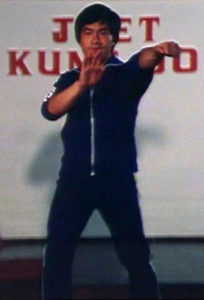
Bruce Li in “Bruce Lee: Father of Jeet Kune Do”
Bruce Lee: Father of Jeet Kune Do (1976) – Somewhat of a Bruceploitation mystery, the existence of Bruce Lee: Father of Jeet Kune Do came to light in a discussion on the Kung Fu Fandom forums in 2010, when a member posted stills and a lobby card for the movie. Featuring Bruce Li (aka Ho Chung-Tao) the stills showed scenes of which, in part, were included in The Real Bruce Lee and Young Bruce Lee. However it became clear that some of the images in question showed scenes that don’t show up in any known Bruce Li production, which for many pointed to the conclusion that they’re from an incomplete Bruce Li flick.
Considering how common it was for many Hong Kong and Taiwan productions of the time to shut down after a few days, for any number of reasons, it could well have been the fate for Bruce Lee: Father of Jeet Kune Do. Hopefully the truth around this one will be revealed in Michael Worth’s upcoming Bruceploitation book and documentary.


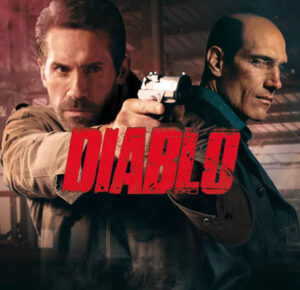
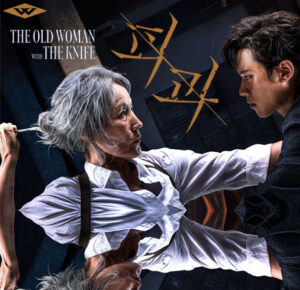
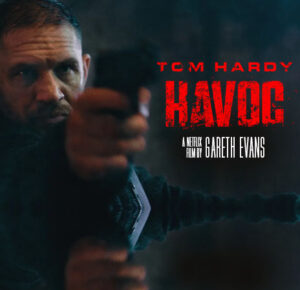
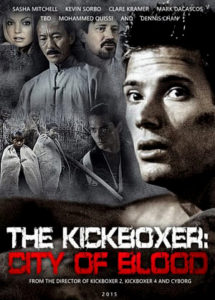
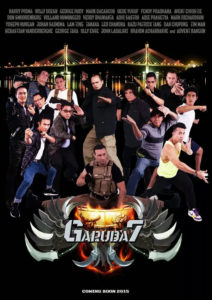
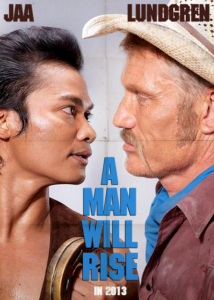

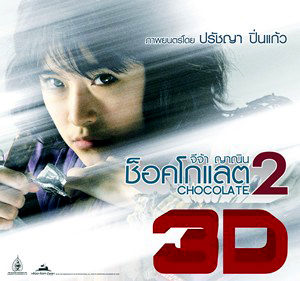

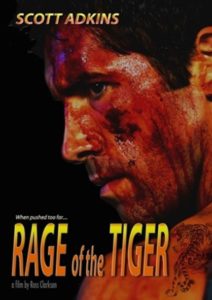
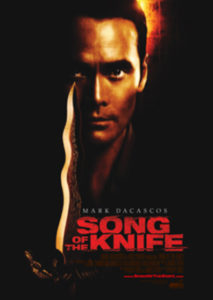
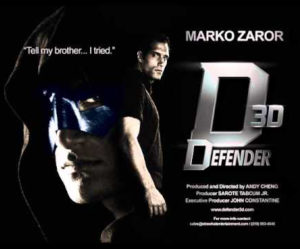
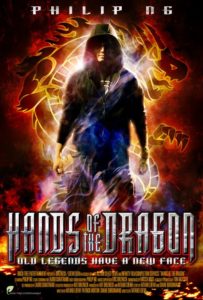

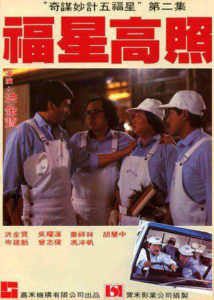
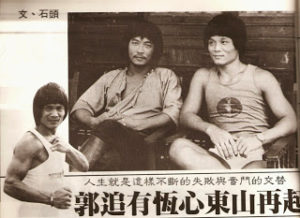


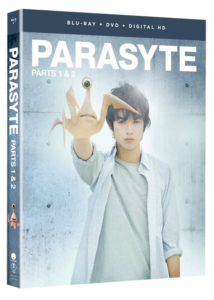
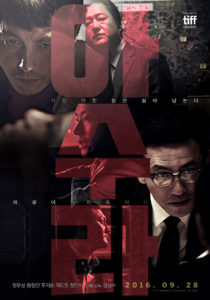

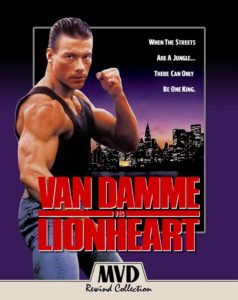
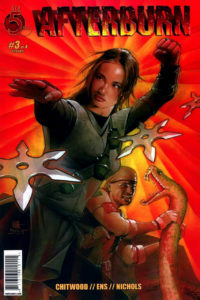

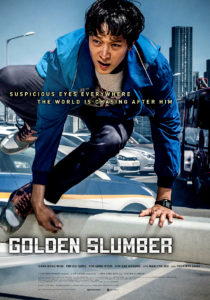
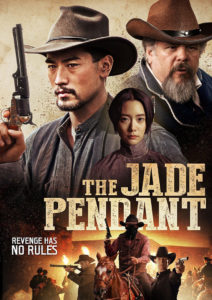
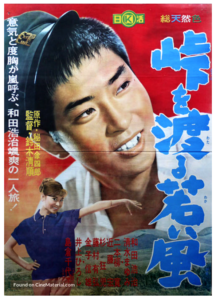
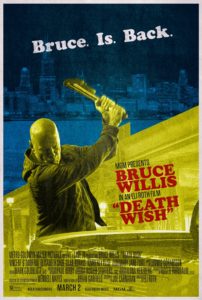

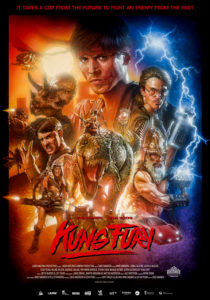
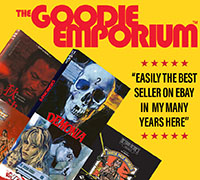

34 Comments